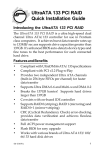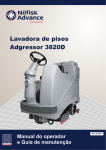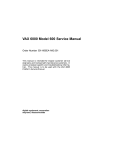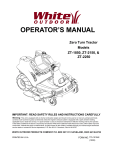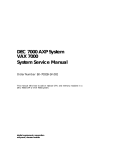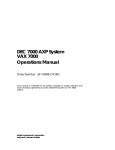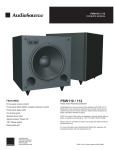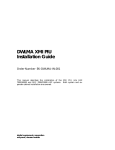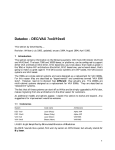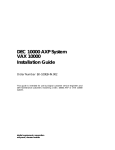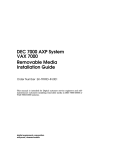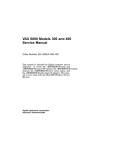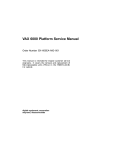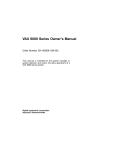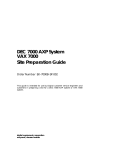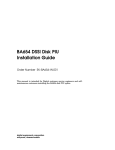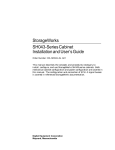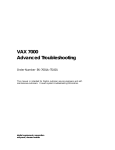Download DEC 7000 AXP, VAX 7000 System Platform Service Manual
Transcript
DEC 7000 AXP System VAX 7000 Platform Service Manual Order Number EK–7000A–SV.001 This manual is intended for Digital service engineers. It includes configuration rules and instructions for the removal and replacement of fieldreplaceable units (FRUs) in the H9F00–AA/AB/AC and H9F00–BA/BB/BC cabinets. digital equipment corporation maynard, massachusetts First Printing, November 1992 The information in this document is subject to change without notice and should not be construed as a commitment by Digital Equipment Corporation. Digital Equipment Corporation assumes no responsibility for any errors that may appear in this document. The software, if any, described in this document is furnished under a license and may be used or copied only in accordance with the terms of such license. No responsibility is assumed for the use or reliability of software or equipment that is not supplied by Digital Equipment Corporation or its affiliated companies. Copyright © 1992 by Digital Equipment Corporation. All Rights Reserved. Printed in U.S.A. The following are trademarks of Digital Equipment Corporation: Alpha AXP AXP DEC DECchip DEC LANcontroller DECnet DECUS DWMVA OpenVMS ULTRIX UNIBUS VAX VAXBI VAXELN VMScluster XMI The AXP logo dT OSF/1 is a registered trademark of the Open Software Foundation, Inc. FCC NOTICE: The equipment described in this manual generates, uses, and may emit radio frequency energy. The equipment has been type tested and found to comply with the limits for a Class A computing device pursuant to Subpart J of Part 15 of FCC Rules, which are designed to provide reasonable protection against such radio frequency interference when operated in a commercial environment. Operation of this equipment in a residential area may cause interference, in which case the user at his own expense may be required to take measures to correct the interference. Contents Preface ..................................................................................................... vii Chapter 1 Configuration Rules 1.1 1.2 1.3 1.4 1.5 1.6 1.6.1 1.6.2 1.6.3 1.6.4 1.6.5 1.6.6 Main Cabinet .......................................................................... 1-2 Expander Cabinet .................................................................. 1-4 Power System ......................................................................... 1-6 LSB Card Cage ....................................................................... 1-8 I/O Interface ......................................................................... 1-10 Plug-In Units ........................................................................ 1-12 XMI Plug-In Unit ........................................................... 1-14 VAXBI Plug-In Unit ...................................................... 1-16 Futurebus+ Plug-In Unit .............................................. 1-18 SCSI Disk and Tape Plug-In Unit ................................ 1-20 DSSI Disk Plug-In Unit ................................................ 1-22 Battery Plug-In Unit ..................................................... 1-24 Chapter 2 Cabinet Doors and Panels 2.1 2.2 2.3 Door and Cable Cover Removal and Replacement ............... 2-2 Top Panel and Air Filter Removal and Replacement .......... 2-4 Side Panel Removal and Replacement ................................. 2-6 Chapter 3 Cabinet Control System 3.1 3.2 3.3 3.4 3.5 Control Panel Removal and Replacement ............................ 3-2 Removable Media Device Removal and Replacement .......... 3-4 Local Disk Converter Removal and Replacement ................ 3-6 Cabinet Control Logic Module Removal and Replacement . 3-8 Pressure Sensor Removal and Replacement ...................... 3-10 iii Chapter 4 Power and Cooling Systems 4.1 4.2 4.3 4.4 Power Regulator Removal and Replacement ....................... 4-2 AC Input Box Removal and Replacement ............................ 4-4 DC Distribution Box Removal and Replacement ................. 4-6 Blower Removal and Replacement ........................................ 4-8 Chapter 5 LSB Card Cage 5.1 5.2 5.3 I/O Cables Removal and Replacement .................................. 5-2 IOP Module Removal and Replacement ............................... 5-4 LSB Card Cage Removal and Replacement ......................... 5-6 Chapter 6 I/O Plug-In Units 6.1 6.2 6.3 Power Regulator Removal and Replacement ....................... 6-2 Enclosure and Card Cage Removal and Replacement ......... 6-4 Air Filter Cleaning ................................................................. 6-6 Chapter 7 Disk Plug-In Units 7.1 7.1.1 7.1.2 7.1.3 7.1.4 7.2 7.2.1 7.2.2 7.2.3 7.2.4 7.2.5 SCSI Disk and Tape Plug-In Unit ......................................... 7-2 Disk or Tape Removal and Replacement ....................... 7-2 Power Supply Removal and Replacement ...................... 7-4 Shelf Removal and Replacement .................................... 7-6 Enclosure Removal and Replacement ............................ 7-8 DSSI Disk Plug-In Unit ....................................................... 7-10 Local Disk Converter Removal and Replacement ....... 7-10 Remote Front Panel Removal and Replacement ......... 7-12 Disk Removal and Replacement ................................... 7-14 Enclosure Removal and Replacement .......................... 7-16 Power and Signal Harness Removal and Replacement................................................................... 7-18 Chapter 8 Battery Plug-In Unit 8.1 8.2 8.3 iv Fuse Removal and Replacement ........................................... 8-2 Cable Removal and Replacement .......................................... 8-4 Battery Removal and Replacement ....................................... 8-6 Appendix A Field-Replaceable Units A.1 A.2 A.3 A.4 A.5 A.6 A.7 A.8 A.9 FRUs Accessible from the Front of the Cabinet ................... A-2 FRUs Accessible from the Rear of the Cabinet .................... A-4 Platform Cables ...................................................................... A-6 FRUs in the XMI Plug-In Unit .............................................. A-8 FRUs in the VAXBI Plug-In Unit ....................................... A-10 FRUs in the Futurebus+ Plug-In Unit ............................... A-12 FRUs in the SCSI Disk and Tape Plug-In Unit ................. A-14 FRUs in the DSSI Disk Plug-In Unit .................................. A-16 FRUs in the Battery Plug-In Unit ...................................... A-18 Figures 1-1 1-2 1-3 1-4 1-5 1-6 1-7 1-8 1-9 1-10 1-11 1-12 1-13 2-1 2-2 2-3 3-1 3-2 3-3 3-4 3-5 4-1 4-2 4-3 4-4 5-1 5-2 5-3 Main Cabinet .......................................................................... 1-2 Expander Cabinet .................................................................. 1-4 System With Two Expander Cabinets (Front View) ............ 1-5 Power System ......................................................................... 1-6 LSB Card Cage (Top View) .................................................... 1-8 I/O Interface ......................................................................... 1-10 Location of PIU Quadrants .................................................. 1-12 XMI Plug-In Unit ................................................................. 1-14 VAXBI Plug-In Unit ............................................................. 1-16 Futurebus+ Plug-In Unit ..................................................... 1-18 SCSI Disk and Tape Plug-In Unit ....................................... 1-20 DSSI Disk Plug-In Unit ....................................................... 1-22 Battery Plug-In Unit ............................................................ 1-24 Cabinet Door and Cable Cover .............................................. 2-2 Top Panel ................................................................................ 2-4 Side Panel ............................................................................... 2-6 Control Panel .......................................................................... 3-2 Removable Media Device ....................................................... 3-4 Local Disk Converter ............................................................. 3-6 Cabinet Control Logic Module (Viewed from Front of Cabinet) .................................................................................. 3-8 Pressure Sensor Location (Viewed from Front of Cabinet) ................................................................................ 3-10 Power Regulators ................................................................... 4-2 AC Input Box .......................................................................... 4-4 DC Distribution Box .............................................................. 4-6 Blower ..................................................................................... 4-8 I/O Cable ................................................................................ 5-2 Rear of LSB Card Cage Showing IOP Module ..................... 5-4 LSB Card Cage ...................................................................... 5-6 v 6-1 6-2 6-3 7-1 7-2 7-3 7-4 7-5 7-6 7-7 7-8 7-9 8-1 8-2 8-3 8-4 A-1 A-2 A-3 A-4 A-5 A-6 A-7 A-8 A-9 I/O PIU Power Regulators ..................................................... 6-2 I/O PIU Enclosure .................................................................. 6-4 I/O PIU Air Filter ................................................................... 6-6 SCSI PIU Disks and Tapes .................................................... 7-2 SCSI PIU Power Supply ........................................................ 7-4 SCSI PIU Shelf ....................................................................... 7-6 SCSI PIU Enclosure ............................................................... 7-8 DSSI PIU — Underside of Brick Cover Showing Local Disk Converter ..................................................................... 7-10 DSSI PIU — Underside of Brick Cover Showing Remote Front Panel ........................................................................... 7-12 DSSI PIU Disks .................................................................... 7-14 DSSI PIU Enclosure ............................................................ 7-16 DSSI PIU Power and Signal Harness ................................. 7-18 Battery PIU Fuse ................................................................... 8-2 Battery PIU (Rear) Showing Cable Routing ......................... 8-4 Battery Hold-Down Brackets ................................................ 8-6 Rear Batteries (Blocks B and C) ........................................... 8-7 Platform Cabinet (Front) Showing FRU Locations .............. A-2 Platform Cabinet (Rear) Showing FRU Locations ............... A-4 Platform Cabinet (Rear and Front) Showing Cables ........... A-6 XMI Plug-In Unit (Front) Showing FRU Locations ............. A-8 VAXBI Plug-In Unit (Front) Showing FRU Locations ....... A-10 Futurebus+ Plug-In Unit (Front) Showing FRU Locations ............................................................................... A-12 SCSI Disk Plug-In Unit (Front) Showing FRU Locations ............................................................................... A-14 DSSI Disk Plug-In Unit (Front) Showing FRU Locations ............................................................................... A-16 Battery Plug-In Unit (Rear) Showing FRU Locations ....... A-18 Tables 1 2 1-1 1-2 vi DEC 7000/VAX 7000 Documentation ..................................... ix Related Documents .................................................................. xi Main Cabinet Variants .......................................................... 1-3 Memory Module Placement ................................................... 1-8 Preface Intended Audience This manual is written for the customer service engineer. Document Structure This manual uses a structured documentation design. Topics are organized into small sections for efficient reference. Each topic begins with an abstract. You can quickly gain a comprehensive overview by reading only the abstracts. Next is an illustration, which also provides quick reference. Last in the structure is a procedure. This manual has eight chapters and one appendix, as follows: • Chapter 1, Configuration Rules, gives you information about configuring each part of the system. • Chapters 2 through 8 provide removal and replacement instructions for each field-replaceable unit: — Chapter 2, Cabinet Doors and Panels — Chapter 3, Cabinet Control System — Chapter 4, Power and Cooling Systems — Chapter 5, LSB Card Cage — Chapter 6, I/O Plug-In Units — Chapter 7, Disk Plug-In Units — Chapter 8, Battery Plug-In Unit • Appendix A contains a quick reference to the location of each fieldreplaceable unit. vii Conventions Used in This Document Terminology. Unless specified otherwise, the use of "system" refers to either a DEC 7000 AXP or VAX 7000 system. The DEC 7000 AXP systems use the Alpha AXP architecture. References in text use DEC 7000 to refer to DEC 7000 AXP systems. When a discussion applies to only one system, an icon is used to highlight that system. Otherwise, the discussion applies to both systems. Thus, the abstract for a module that applies only to DEC 7000 systems would look like this: This section shows a sample boot of Open VMS Alpha AXP DEC from the RRD42 CD drive for DEC 7000 systems. The first 7000 step is issuing the show device command to determine the location of the RRD42. Book titles. In text, if a book is cited without a product name, that book is part of the hardware documentation. It is listed in Table 1 along with its order number. Icons. The icons shown below are used in illustrations for designating part placement in the system described. A shaded area in the icon shows the location of the component or part being discussed. Front Rear Part numbers. Part numbers are listed in Appendix A of this manual. Documentation Titles Table 1 lists the books in the DEC 7000 and VAX 7000 documentation set. Table 2 lists other documents that you may find useful. viii Table 1 DEC 7000/VAX 7000 Documentation Title Order Number Installation Kit EK–7000B–DK Site Preparation Guide EK–7000B–SP Installation Guide EK–700EB–IN Hardware User Information Kit EK–7001B–DK Operations Manual EK–7000B–OP Basic Troubleshooting EK–7000B–TS Service Information Kit—VAX 7000 EK–7002A–DK Platform Service Manual EK–7000A–SV System Service Manual EK–7002A–SV Pocket Service Guide EK–7000A–PG Advanced Troubleshooting EK–7001A–TS Service Information Kit—DEC 7000 EK–7002B–DK Platform Service Manual EK–7000A–SV System Service Manual EK–7002B–SV Pocket Service Guide EK–7700A–PG Advanced Troubleshooting EK–7701A–TS ix Table 1 DEC 7000/VAX 7000 Documentation (Continued) Title Order Number Reference Manuals Console Reference Manual EK–70C0B–TM KA7AA CPU Technical Manual EK–KA7AA–TM KN7AA CPU Technical Manual EK–KN7AA–TM MS7AA Memory Technical Manual EK–MS7AA–TM I/O System Technical Manual EK–70I0A–TM Platform Technical Manual EK–7000A–TM Upgrade Manuals x KA7AA CPU Installation Guide EK–KA7AA–IN KN7AA CPU Installation Guide EK–KN7AA–IN MS7AA Memory Installation Guide EK–MS7AA–IN KZMSA Adapter Installation Guide EK–KXMSX–IN DWLMA XMI PIU Installation Guide EK–DWLMA–IN DWMBB VAXBI PIU Installation Guide EK–DWMBB–IN H7237 Battery PIU Installation Guide EK–H7237–IN H7263 Power Regulator Installation Guide EK–H7263–IN BA654 DSSI Disk PIU Installation Guide EK–BA654–IN BA655 SCSI Disk and Tape PIU Installation Guide EK–BA655–IN Removable Media Installation Guide EK–TFRRD–IN Table 2 Related Documents Title Order Number General Site Preparation Site Environmental Preparation Guide EK–CSEPG–MA System I/O Options BA350 Modular Storage Shelf Subsystem Configuration Guide EK–BA350–CG BA350 Modular Storage Shelf Subsystem User’s Guide EK–BA350–UG BA350-LA Modular Storage Shelf User’s Guide EK–350LA–UG CIXCD Interface User Guide EK–CIXCD–UG DEC FDDIcontroller 400 Installation/Problem Solving EK–DEMFA–IP DEC LANcontroller 400 Installation Guide EK–DEMNA–IN DEC LANcontroller 400 Technical Manual EK–DEMNA–TM DSSI VAXcluster Installation and Troubleshooting Manual EK–410AA–MG InfoServer 150 Installation and Owner’s Guide EK–INFSV–OM KDM70 Controller User Guide EK–KDM70–UG KFMSA Module Installation and User Manual EK–KFMSA–IM KFMSA Module Service Guide EK–KFMSA–SV RRD42 Disc Drive Owner’s Manual EK–RRD42–OM RF Series Integrated Storage Element User Guide EK–RF72D–UG TF85 Cartridge Tape Subsystem Owner’s Manual EK–OTF85–OM TLZ06 Cassette Tape Drive Owner’s Manual EK–TLZ06–OM xi Table 2 Related Documents (Continued) Title Order Number Operating System Manuals Alpha Architecture Reference Manual EY–L520E–DP DEC OSF/1 Guide to System Administration AA–PJU7A–TE DECnet for OpenVMS Network Management Utilities AA–PQYAA–TK Guide to Installing DEC OSF/1 AA–PS2DA–TE OpenVMS Alpha Version 1.0 Upgrade and Installation Manual AA–PQYSA–TE VMS Upgrade and Installation Supplement: VAX 7000–600 and VAX 10000–600 Series AA–PRAHA–TE VMS Network Control Program Manual AA–LA50A–TE VMSclusters and Networking HSC Installation Manual EK–HSCMN–IN SC008 Star Coupler User’s Guide EK–SC008–UG VAX Volume Shadowing Manual AA–PBTVA–TE Peripherals Installing and Using the VT420 Video Terminal EK–VT420–UG LA75 Companion Printer Installation and User Guide EK–LA75X–UG xii Chapter 1 Configuration Rules This chapter provides configuration information for the following system components: • Main Cabinet • Expander Cabinet • Power System • LSB Card Cage • I/O Interface • Plug-In Units — XMI Plug-In Unit — VAXBI Plug-In Unit — Futurebus+ Plug-In Unit — SCSI Disk and Tape Plug-In Unit — DSSI Disk Plug-In Unit — Battery Plug-In Unit Configuration Rules 1-1 1.1 Main Cabinet Figure 1-1 shows the components of the main cabinet. Configuration of these components is discussed in this chapter. Figure 1-1 Main Cabinet Front Rear Cabinet Control System LSB Card Cage Power System Cooling System Plug-In Units BXB-0021H-92 1-2 Configuration Rules About the Main Cabinet The main cabinet, H9F00–AA/AB/AC, contains the following components: • Cabinet control system • LSB card cage with processor, memory, and IOP modules • Power and cooling systems • One or more plug-in units for: — I/O — Disks — Batteries A removable media device (RRD421 in DEC 7000 systems; TF85 in VAX 7000 systems) is optional. If used, it is mounted next to the control panel in the main system cabinet. Variants of the main cabinet are listed in Table 1-1. Table 1-1 Main Cabinet Variants Part Number Regulator H9F00–AA 120/208 V, 60 Hz H9F00–AB 220-240/380-415 V, 50 Hz H9F00–AC 202 V, 50-60 Hz 1 The RRD42 requires a dedicated KZMSA port in an XMI plug-in unit in the main cabinet. Configuration Rules 1-3 1.2 Expander Cabinet The expander cabinet looks like the main cabinet, but without an LSB card cage or a control panel. Disk plug-in units may be installed in the space that would be occupied by the LSB card cage. Figure 1-2 Expander Cabinet Front Disk Plug-In Units Rear Power System Cooling System Plug-In Units BXB-0032J-92 1-4 Configuration Rules About the Expander Cabinet The expander cabinet, H9F00–BA/BB/BC, is similar to the main cabinet. The second letter of each variant identifies voltage (see Table 1-1 for these voltages). The expander cabinet frame is identical to the main cabinet; the contents, however, differ. The expander cabinet does not have an LSB card cage or a control panel, and it can have disk plug-in units in the upper part of the cabinet. Expander Cabinet Configuration Rules • Each system may have a maximum of two expander cabinets. The first expander cabinet is placed to the right of the system cabinet and the second to the left. See Figure 1-3. • The expander cabinet may contain a removable media device (RRD421 in DEC 7000 systems; TF85 in VAX 7000 systems). If used, it is located in the front of the expander cabinet, at the top. • The configuration rules for the lower quadrants of the system cabinet also apply to the lower quadrants of the expander cabinet. • The only plug-in units that may be installed in the upper quadrants of the expander cabinet are disk plug-in units. Figure 1-3 System With Two Expander Cabinets (Front View) Second Expander Cabinet Main Cabinet First Expander Cabinet BXB-0001M-92 1 The RRD42 requires a dedicated KZMSA port in an XMI plug-in unit in the same expander cabinet. Configuration Rules 1-5 1.3 Power System The power system consists of the AC input box, DC distribution box, and power regulators. This section includes configuration information for power regulators. Figure 1-4 Power System Front Rear Power Regulators AC Input Box DC Distribution Box BXB-0052E-92 1-6 Configuration Rules About the Power System • The power system consists of the AC input box, DC distribution box, and a minimum of one and a maximum of three power regulators. (See Figure 1-4.) • The maximum system configuration requires two regulators; the third is for optional redundant power. • Power regulators cannot be warm swapped. • Each plug-in unit (with the exception of the battery plug-in unit) has a local power supply that generates the needed +5V and other miscellaneous DC voltages. Power Regulator Configuration When viewed from the front of the system cabinet, the leftmost power regulator (closest to the LSB card cage) corresponds to phase A, the middle with phase B, and the rightmost with phase C (see Figure 1-4). Power regulators are configured in manufacturing starting closest to the LSB card cage and working to the right. This platform, with one regulator installed, constitutes a true single-phase load. The load currents in three-phase power distribution need to be balanced. If necessary, reconfigure the regulators (and batteries, if the cabinet contains a battery plug-in unit) in multiple-system installations to balance the three-phase currents and to reduce stresses in the common neutral conductor. Configuration Rules 1-7 1.4 LSB Card Cage The LSB card cage contains nine module slots. The minimum configuration is a processor module in slot 0, a memory module in slot 7, and the I/O port module in slot 8. This section gives placement rules for other configurations. Figure 1-5 LSB Card Cage (Top View) Front Rear Power Filter 4 Additional CPUs or Memories First CPU 3 5 2 6 Additional Memories or CPUs 1 7 First Memory 0 8 IOP Module Centerplane BXB-0094C-92 Table 1-2 Memory Module Placement Number of Processor Modules Memory Module: 1st 2nd 3rd 4th 5th 6th 7th 1 7 1 6 2 5 3 4 2 7 6 2 5 3 4 — 3 7 6 5 3 4 — — 4 7 6 5 4 — — — 5* 7 6 5 — — — — 6* 7 6 — — — — — *Insert these processor modules after all memory modules have been inserted. 1-8 Configuration Rules About the LSB Card Cage • The LSB card cage has slots for nine modules. These modules are a combination of processor (KN7AA–AA or KA7AA-AA), memory (MS7AA–AA, –BA, –CA, –DA), and I/O port (IOP, E2044–AA) modules. • The maximum number of processor modules is six. • The maximum number of memory modules is seven. Memory modules may reside in slots 1 through 7 only. • The maximum amount of memory in a DEC 7000 system is 14 Gbytes; in a VAX 7000 system it is 3.5 Gbytes. Memory module sizes are 64 Mbyte (MS7AA–AA), 128 Mbyte (MS7AA–BA), 256 Mbyte (MS7AA– CA), and 512 Mbyte (MS7AA–DA). All but the 64-Mbyte module support two-way interleaving. Mixed sizes of memory modules may be installed in the LSB card cage. • Each system must have one IOP module, which must reside in slot 8. • The minimum configuration is one processor module, one memory module, and one IOP module. In this configuration, the processor module must reside in slot 0 and the memory module in slot 7. Module Placement Rules Due to the speed of the LSB bus, these rules must be followed. The goal is to keep all modules as close together as possible. This is best accomplished by alternating memory modules between the front and rear of the card cage. Configure modules in this order: 1. Check that the IOP module is in slot 8. 2. Place the first four processor modules starting in slot 0 through slot 3. 3. Next configure memory modules as shown in Table 1-21. 4. Insert any remaining processor modules in open slots with the highest node ID numbers. (The node ID number is the same as the slot number.) 5. Install filler modules in any unused slots to ensure proper airflow. 1 Table 1-2 shows the slot in which each memory module is installed depending on the number of processor modules in the system. For example, if the system contains two processor modules and three memory modules, the first memory module is installed in slot 7, the second in slot 6, and the third in slot 2. Configuration Rules 1-9 1.5 I/O Interface The I/O interface consists of the IOP module in the LSB card cage and the I/O cables, which connect the IOP module to the I/O bus. Figure 1-6 I/O Interface Rear Expander Rear Main IOP Module I/O Cable BXB-0032L-92 1-10 Configuration Rules About the I/O Interface The I/O interface consists of the I/O port (IOP) module in slot 8 of the LSB card cage and two unidirectional cables for each I/O channel. The IOP module can accommodate a maximum of four I/O channels. I/O Interface Configuration • Each system must have an IOP module. • The IOP module can accommodate one to four I/O channels. • Each I/O bus is housed in a plug-in unit (PIU). • An I/O cable connects the IOP module to an I/O PIU. • The maximum length of each I/O cable is 3 meters (10 feet). • Each I/O cable consists of two separate unidirectional interconnects. Configuration Rules 1-11 1.6 Plug-In Units Plug-in units (PIUs) are located in the main and expander cabinets as shown in Figure 1-7. Both cabinets have space for PIUs in the bottom. The expander cabinet also has PIU quadrants in the top. Figure 1-7 Location of PIU Quadrants Front Main Cabinet Rear PIU Quadrant 3 PIU Quadrant 1 PIU Quadrant 2 PIU Quadrant 4 Front Expander Cabinet Rear PIU Quadrant 5 PIU Quadrant 1 PIU Quadrant 6 PIU Quadrant 3 PIU Quadrant 4 PIU Quadrant 2 BXB-0044K-92 1-12 Configuration Rules About Plug-In Units • Plug-in units (PIUs) house options in the main and expander cabinets. • These options are housed in PIUs: — XMI — VAXBI — Futurebus+ — SCSI disks and tapes — DSSI disks — Batteries • PIUs are located in the PIU quadrants, as shown in Figure 1-7. The main cabinet has four PIU quadrants, and the expander cabinet has six. • The XMI, VAXBI, and battery PIUs each require two quadrants; the Futurebus+ and disk PIUs each require one quadrant. Configuration rules for each of these PIUs are discussed in the following sections. Configuration Rules 1-13 1.6.1 XMI Plug-In Unit The XMI PIU houses an XMI card cage and power regulators. The XMI PIU is located in the bottom of the main cabinet or expander cabinet. Figure 1-8 XMI Plug-In Unit BXB-0368-92 1-14 Configuration Rules About the XMI Plug-In Unit • An XMI PIU is shown in Figure 1-8. • The maximum number of XMI PIUs per cabinet is two. The maximum per system is four. XMI PIU Configuration Rules • Each XMI PIU occupies two quadrants (Q1 and Q2 or Q3 and Q4 — see Figure 1-7). When the cabinet includes a VAXBI PIU, the XMI PIU must be in quadrants Q1 and Q2. • The total number of dual I/O panels on the XMI bulkhead is 20. One of these is used for the I/O cable from the IOP module. XMI Configuration Rules • Each XMI backplane has 12 slots of usable I/O space. The backplane has 14 slots, two of which are reserved for the T2030–YA and T2028– YA modules, leaving 12 slots for I/O. • The clock and arbitration module (T2030–YA) must reside in slot 7. • The T2028–AA module, which is the interface between the LSB and XMI buses, must reside in slot 8. • The first option must reside in either slot 1 or slot 14 to terminate the XMI bus. If the option is a two-module set, the module with the XMI corner must be in slot 1 or slot 14. • If the cabinet has a VAXBI PIU, the T2018 module (XBIA+) must reside in slot 1 of the XMI backplane. Configuration Rules 1-15 1.6.2 VAXBI Plug-In Unit The VAXBI PIU houses a VAXBI card cage and power regulators. The VAXBI PIU is located in the bottom of the main cabinet or expander cabinet. Figure 1-9 VAXBI Plug-In Unit BXB-0368A-92 1-16 Configuration Rules About the VAXBI Plug-In Unit • A VAXBI PIU is shown in Figure 1-9. • The maximum number of VAXBI PIUs per cabinet is one. The maximum per system is three (assuming a main cabinet and two expander cabinets). VAXBI PIU Configuration Rules • The VAXBI PIU occupies two quadrants (Q3 and Q4 — see Figure 1-7). • An XMI PIU must reside in the same cabinet as a VAXBI PIU, in quadrants Q1 and Q2. VAXBI Configuration Rules • Each VAXBI backplane has 11 slots of usable I/O space. • The T1043 module (XBIB) must reside in slot 12 of the VAXBI backplane; the T2018 module (XBIA+) must reside in slot 1 of the XMI backplane. Configuration Rules 1-17 1.6.3 Futurebus+ Plug-In Unit The Futurebus+ PIU houses a Futurebus+ card cage and DEC power regulators. The Futurebus+ PIU is located in the 7000 bottom of the main cabinet or expander cabinet. Figure 1-10 Futurebus+ Plug-In Unit BXB-0368B-92 1-18 Configuration Rules About the Futurebus+ Plug-In Unit • A Futurebus+ PIU is shown in Figure 1-10. • The maximum number of Futurebus+ PIUs per cabinet is two. The maximum number per system is three. Futurebus+ Configuration Rules • Each Futurebus+ PIU occupies one quadrant (Q2 or Q4 — see Figure 1-7). • The B2003–AA module must reside in slot 5 of the Futurebus+ card cage. • The system must include an XMI bus. Configuration Rules 1-19 1.6.4 SCSI Disk and Tape Plug-In Unit The SCSI disk and tape PIU houses any combination of 3.5DEC inch disk and tape drives and 5.25-inch disk drives. This 7000 PIU is located in the bottom of the main cabinet or in the top or bottom of the expander cabinet. Figure 1-11 SCSI Disk and Tape Plug-In Unit BXB-0369A-92 1-20 Configuration Rules About the SCSI Disk and Tape Plug-In Unit • The maximum number of SCSI disk and tape PIUs is two in the main cabinet and four in the expander cabinet. • Each SCSI disk PIU contains two shelves. Each shelf contains seven slots for disks and tapes, in any combination. • Each 3.5-inch disk or tape uses one slot: — RZ26–VA disk — TLZ06–VA tape • Each 5.25-inch disk uses three slots: — RZ73–VA disk SCSI Disk and Tape PIU Configuration Rules • The SCSI disk PIU can occupy any quadrant (see Figure 1-7). • The arrow on the rear panel of the PIU enclosure must point toward the blower. That is, the arrow must point up if the PIU is in Q1 through Q4; it must point down if the PIU is in Q5 or Q6. Configuration Rules 1-21 1.6.5 DSSI Disk Plug-In Unit The DSSI disk PIU houses one to three bricks; each brick VAX contains two 5.25-inch disk drives. This PIU is located in 7000 the bottom of the main cabinet or in the top or bottom of the expander cabinet. Figure 1-12 DSSI Disk Plug-In Unit Brick BXB-0359A-92 1-22 Configuration Rules About the DSSI Disk Plug-In Unit • The maximum number of DSSI disk PIUs is two in the main cabinet and four in the expander cabinet. • Each DSSI disk PIU contains a minimum of one and a maximum of three bricks; each brick contains two 5.25-inch form factor disks. DSSI Disk PIU Configuration Rules • The DSSI disk PIU can occupy any quadrant (see Figure 1-7). • In the system cabinet or in the bottom of the expander cabinet, bricks are installed starting closest to the blower and working down. • In the top of the expander cabinet, bricks are installed starting closest to the blower and working up. • The arrow on the rear panel of the PIU enclosure must point toward the blower. That is, the arrow must point up if the PIU is in Q1 through Q4; it must point down if the PIU is in Q5 or Q6. Configuration Rules 1-23 1.6.6 Battery Plug-In Unit The battery PIU houses one to three battery blocks; each block contains four batteries. The battery PIU is located in the bottom of the main cabinet or expander cabinet. Figure 1-13 Battery Plug-In Unit Block A Block B Block C BXB-0367-92 1-24 Configuration Rules About the Battery Plug-In Unit • The maximum number of battery PIUs is one in the main cabinet and one in each expander cabinet. • Each battery PIU contains a minimum of one and a maximum of three blocks of batteries. Each block contains four batteries. • One block of batteries is required for each power regulator in the cabinet. Battery PIU Configuration Rules • The battery PIU occupies two quadrants, Q3 and Q4 (see Figure 1-7). • The battery block labeled A in Figure 1-13 is in the rear when the battery PIU is installed in the cabinet. It consists of two batteries in the top tray and two batteries in the bottom. Battery block B is in the front when the PIU is installed in the cabinet. It consists of four batteries in the top tray. Battery block C is also in the front; it consists of four batteries in the bottom tray. • Battery block A corresponds to power regulator A (see Figure 1-4), battery block B to power regulator B, and battery block C to power regulator C. • If you reconfigure the power regulators (see page 1-9), you must also reconfigure the batteries. Configuration Rules 1-25 Chapter 2 Cabinet Doors and Panels This chapter contains the following sections: • Door and Cable Cover Removal and Replacement • Top Panel and Air Filter Removal and Replacement • Side Panel Removal and Replacement Cabinet Doors and Panels 2-1 2.1 Door and Cable Cover Removal and Replacement Replace the doors and cable cover only if they sustain cosmetic damage. The front and rear doors attach to the cabinet with spring-loaded latch pins; the cable cover attaches with quarterturn Phillips screws. Figure 2-1 Cabinet Door and Cable Cover 2 Rear 3 1 BXB-0398-92 2-2 Cabinet Doors and Panels Door Removal 1. Open the door. 2. Locate the spring-loaded latch in the upper corner of the door. See in Figure 2-1. Pull the pin down. 3. Lift the bottom of the door off the hinge pin. See 2 3. Door Replacement Reverse steps 1–3 in the Removal section above. Cable Cover Removal 1. Remove the two screws (quarter-turn Phillips) — one in each of the upper corners of the cable cover. See 1 in Figure 2-1. 2. Swing the cable cover down and remove it from the hinges on the bottom. Cable Cover Replacement Reverse steps 1–2 in the Removal section above. Cabinet Doors and Panels 2-3 2.2 Top Panel and Air Filter Removal and Replacement The top panel attaches to the cabinet with one Phillips screw and four plastic snaps. Remove the top cover to gain access to some field replaceable units or to replace the top air filter. CAUTION: Obstructions on the top panel may cause the system to shut down. Figure 2-2 Top Panel 1 Rear BXB-0398A-92 2-4 Cabinet Doors and Panels Top Panel Removal 1. Remove the screw (Phillips) at the rear of the top panel. See ure 2-2. 2. Lift the top panel until the plastic snaps disengage. 1 in Fig- Top Panel Replacement 1. Position the top panel on the cabinet and push it down until the plastic snaps engage. 2. Replace the screw removed in step 1 of the Removal section. Top Air Filter Removal 1. Remove the top panel (see above). 2. Grasp the foam air filter and pull it away from the top panel. No tools are required. 3. Discard the foam air filter. Top Air Filter Replacement 1. Lay the replacement air filter over the mesh on the top panel. 2. Push the edges of the foam under the edges of the opening. 3. Replace the top panel. Cabinet Doors and Panels 2-5 2.3 Side Panel Removal and Replacement The side panel attaches to the cabinet with two bolts at the top and brackets on the inside of the panel. Figure 2-3 Side Panel 2 1 1 1 BXB-0335B-92 2-6 Cabinet Doors and Panels Removal 1. Remove the top panel. See Section 2.2. 2. Use a 10 mm hex socket wrench to remove the bolts in the upper corners of the side panel. See 2 in Figure 2-3. 3. Lift the panel up and away from the cabinet. Replacement 1. Place the panel on the side of the cabinet so that all three brackets on the inside of the side panel rest in the U-shaped channels on the side of the cabinet. See 1 in Figure 2-3. 2. Replace the bolts removed in step 2 of the Removal section. 3. Replace the top panel. Cabinet Doors and Panels 2-7 Chapter 3 Cabinet Control System This chapter contains the following sections: • Control Panel Removal and Replacement • Removable Media Device Removal and Replacement • Local Disk Converter Removal and Replacement • Cabinet Control Logic Module Removal and Replacement • Pressure Sensor Removal and Replacement Cabinet Control System 3-1 3.1 Control Panel Removal and Replacement The control panel bezel attaches to the cabinet with two Phillips screws. The circuit board attaches to the back side of the bezel with four clips. Access is from the front of the cabinet. Figure 3-1 Control Panel Disable Secure Enable Left Expander Restart Key On Front Right Expander Run Fault Console 4 5 7 7 Back side of control panel 7 7 5 BXB-0370-92 3-2 Cabinet Control System Removal 1. Turn the keyswitch to Disable. Remove the key. 2. Shut the circuit breaker off by pushing down the handle. 3. Open the front door of the cabinet. 4. Remove the two screws (Phillips) on the left side of the control panel. See 4 in Figure 3.1. 5. Swing the panel to the right no more than two inches and remove it from the hinges. See 5 . 6. Disconnect the cables from the circuit board. 7. Place the control panel face down on a flat surface. Remove the circuit board by easing the clips away from the board and pulling the board up. See 7 . Replacement • Reverse the steps in the Removal procedure above. Cabinet Control System 3-3 3.2 Removable Media Device Removal and Replacement The removable media device is housed in a box mounted on rails in the cabinet. Slotted captive screws hold the box in the cabinet; Phillips screws attach the top to the box and the removable media device to the box. Access is from the front of the cabinet. Figure 3-2 Removable Media Device 7 Front 8 5 BXB-0371-92 3-4 Cabinet Control System Removal 1. Turn the keyswitch to Disable. 2. Open the rear door of the cabinet and shut the circuit breaker off by pushing down the handle. 3. Remove all cable connectors from the rear of the removable media box. 4. Remove the control panel. See Section 3.1. 5. Loosen the two captive screws (slotted) at the lower sides of the removable media box. See 5 in Figure 3-2. 6. Slide the removable media box out of the cabinet and place it on a stable work surface. 7. Remove the top cover of the removable media box by removing the nine screws (Phillips) and lifting the cover off. See 7 . 8. Remove the four screws (Phillips) that hold the removable media device in place. There are two screws on each side of the box. See 8 . 9. Slide the removable media device out of the box. 10. Remove the cable connectors from the rear of the adapter board that is in the bottom of the box, under the removable media device. 11. Push down on the two clips that hold the rear of the adapter board and remove the board. Replacement • Reverse the steps in the Removal procedure above. Cabinet Control System 3-5 3.3 Local Disk Converter Removal and Replacement The local disk converter (LDC) is housed in the removable media box (Section 3.2). Phillips screws attach the circuit board to the box. Access is from the front of the cabinet. Figure 3-3 Local Disk Converter 7 Front 8 5 BXB-0371A-92 3-6 Cabinet Control System Removal 1. Turn the keyswitch to Disable. 2. Open the rear door of the cabinet and shut the circuit breaker off by pushing down the handle. 3. Remove all cable connectors from the rear of the removable media box. 4. Remove the control panel. See Section 3.1. 5. Loosen the two captive screws (slotted) at the lower sides of the removable media box. See 5 in Figure 3-3. 6. Slide the removable media box out of the cabinet and place it on a stable work surface. 7. Remove the top cover of the removable media box by removing the nine screws (Phillips) and lifting the cover off. See 7 . 8. Disconnect the four cables from the local disk converter module. See 8. 9. Remove the local disk converter module by removing the four screws (Phillips) from the corners of the module. Use a long screwdriver, and insert it through the holes on the side of the removable media box opposite the local disk converter module. Replacement • Reverse the steps in the Removal procedure above. Cabinet Control System 3-7 3.4 Cabinet Control Logic Module Removal and Replacement The cabinet control logic (CCL) module is mounted on a slide plate with Phillips screws. The slide plate is held in place with slotted captive screws. Access is from the rear of the cabinet. Figure 3-4 Front Cabinet Control Logic Module (Viewed from Front of Cabinet) 5 8 4 7 BXB-0363-92 3-8 Cabinet Control System Removal 1. Turn the keyswitch to Disable. 2. Shut the circuit breaker off by pushing down the handle. 3. Ground yourself to the cabinet with the antistatic wrist strap from the Electrical Safety Kit. 4. At the rear of the system, remove the rear panel of the cabinet control system box. See 4 in Figure 3-4. 5. If a DEC power bus cable is connected to the end of the slide plate on which the cabinet control logic module is mounted, remove the connector. See 5 . 6. Remove all connectors from the cabinet control logic module. 7. Disconnect the plastic hose from the pressure sensor. See 8. Loosen the two captive screws (slotted) on the end of the slide plate. See 8 . 9. Pull the slide plate out. 7 . 10. Remove the cabinet control logic module from the slide plate by removing the six screws (Phillips) that are in the corners and the center of each long side. Replacement • Reverse the steps in the Removal procedure above. Reattach the plastic hose (disconnected in step 7 above) to the outlet of the pressure sensor that faces away from the module. IMPORTANT: The system will not power up completely if this hose is left unattached. Cabinet Control System 3-9 3.5 Pressure Sensor Removal and Replacement The pressure sensor is mounted on the CCL module (Section 3.4). Access is from the rear of the cabinet. Figure 3-5 Pressure Sensor Location (Viewed from Front of Cabinet) 3 Front Air Pressure Sensor BXB-0044L-92 3-10 Cabinet Control System Removal 1. Remove the cabinet control logic module. See Section 3.4. 2. On the back side of the cabinet control logic module, remove the two screws (slotted) that hold the pressure sensor in place. 3. Disconnect the two spade lugs from the side of the pressure sensor. See 3 in Figure 3-5. Replacement • Reverse the steps in the Removal procedure above. Cabinet Control System 3-11 Chapter 4 Power and Cooling Systems This chapter contains the following sections: • Power Regulator Removal and Replacement • AC Input Box Removal and Replacement • DC Distribution Box Removal and Replacement • Blower Removal and Replacement Power and Cooling Systems 4-1 4.1 Power Regulator Removal and Replacement The power regulators attach to the cabinet with Phillips captive screws. Access is from the front of the cabinet. WARNING: Figure 4-1 The power regulator has a heated surface on one side. Power Regulators 4 1 Front A B C 4 BXB-0064D-92 4-2 Power and Cooling Systems Removal 1. Turn the keyswitch to Disable. 2. Open the front and rear doors of the cabinet. 3. At the rear of the cabinet, shut the circuit breaker off by pushing down the handle. To ensure that the circuit breaker is not unintentionally switched on again, flip the lockout tag down. Lock the tag in place with the padlock from the Electrical Safety Toolkit. Place the padlock in the bottom hole of the bracket on either side of the tag. (See Section 4.2, step 4.) 4. From the front of the cabinet, loosen the two captive screws (Phillips), one each at the top and bottom of the power regulator to be removed. See 4 in Figure 4-1. WARNING: One side of the power regulator is a heated surface. Do not touch the side when removing the power regulator. CAUTION: The power regulator weighs 20 kg (40.4 lb). Because of the height of this unit in the cabinet, you should not remove the power regulator from the cabinet by yourself. 5. Slide the power regulator out from the front of the cabinet. There will be some resistance. Replacement 1. From the front of the cabinet, seat the replacement power regulator in its slot and push it in as far as it will go without lifting the precharge stop (see 1 in Figure 4-1). Wait 5 seconds, and then lift the precharge stop and push the power regulator in the rest of the way. 2. Tighten the captive screws at the top and bottom of the power regulator. Power and Cooling Systems 4-3 4.2 AC Input Box Removal and Replacement The AC input box attaches to the cabinet with slotted captive screws; the ground strap attaches to the AC input box with an 8 mm nut. Removal and replacement require access to both the front and rear of the cabinet. Figure 4-2 AC Input Box 7 Front 7 10 4 Rear 8 BXB-0374-92 4-4 Power and Cooling Systems Removal 1. Turn the keyswitch to Disable. 2. Open the front and rear doors of the cabinet. 3. At the rear of the cabinet, shut the circuit breaker off by pushing down the handle. 4. To ensure that the circuit breaker is not unintentionally switched on again, flip the lockout tag down. See 4 in Figure 4-2. Lock the tag in place with the padlock from the Electrical Safety Toolkit. Place the padlock in the bottom hole of the bracket on either side of the tag. 5. Disconnect the system power cord. 6. From the front of the cabinet, remove all power regulators and filler modules. See Section 4.1 for power regulator removal. To remove any filler modules, do the following: a. Loosen the captive screws at the top and bottom of the filler module. b. Grasp the handles and remove the filler module by sliding it forward. 7. Loosen the four captive screws on the front of the AC input box. See (shown with power regulators removed). 8. At the rear of the cabinet, remove the ground strap at the AC input box end (8 mm nut). See 8 . 9. Remove the right plastic cover from the DC distribution box (above the AC input box). 7 10. Hold the AC input box to prevent it from falling. Pull the bracket attached to the DC distribution box up and push the bracket to the right to hold it in place. See 10. (This bracket is partially obscured by the left plastic cover on the DC distribution box. Do not remove this plastic cover.) 11. Remove the AC input box from the rear of the cabinet. Replacement • Reverse the steps in the Removal procedure above. Power and Cooling Systems 4-5 4.3 DC Distribution Box Removal and Replacement The DC distribution box is installed in the cabinet with Phillips screws. Connections to the assembly use 8 mm and 10 mm nuts. Removal and replacement require access to both the front and rear of the cabinet. Figure 4-3 DC Distribution Box 12 13 Rear Front 6 11 6 9 10 14 BXB-0373-92 4-6 Power and Cooling Systems Removal 1. Turn the keyswitch to Disable. 2. Open the front and rear doors of the cabinet. 3. At the rear of the cabinet, shut the circuit breaker off by pushing down the handle. To ensure that the circuit breaker is not unintentionally switched on again, flip the lockout tag down. Lock the tag in place with the padlock from the Electrical Safety Toolkit. Place the padlock in the bottom hole of the bracket on either side of the tag. (See Section 4.2, step 4.) 4. Disconnect the system power cord. 5. From the front of the cabinet, remove the power regulators. See Section 4.1. 6. Remove the eight screws (Phillips) from the top and bottom flanges (four each). See 6 in Figure 4-3. 7. From the rear of the cabinet, remove the AC input box. See Section 4.2. 8. If this cabinet has a battery plug-in unit, disconnect the two-pin connector in each block of batteries. See Section 8.1, steps 3 and 4. 9. At the rear of the cabinet, remove the plastic covers from the battery terminals and the DC distribution bars. See 9 . 10. Remove all 48VDC connections (8 mm nuts). See 10 . 11. Disconnect any battery connections (10 mm nuts). See 12. If present, disconnect the battery sense cable. See 13. Disconnect the control/status cable. See 11 . 12 . 13 . 14. Remove the four flathead screws (Phillips) from the floor of the enclosure. See 14 . 15. Pull the DC distribution box out from the front. Replacement 1. Reverse the above steps. When reconnecting the 48 VDC and battery connections (steps 10 and 11 above), torque the nuts to 2.5 newtonmeters (22 inch-pounds). 2. Check that battery connections (step 11 above) are correct. 3. Check that 48V connections (step 10 above) are correct. Power and Cooling Systems 4-7 4.4 Blower Removal and Replacement The blower attaches to the cabinet with Phillips screws. Removal and replacement require two persons and access to the front and rear of the cabinet. WARNING: Figure 4-4 The blower weighs 25 kg (55 lb). Blower Front 8 4 5 Rear 6 4-8 Power and Cooling Systems BXB-0022B-92 Removal 1. Turn the keyswitch to Disable. 2. Open the rear door of the cabinet. Shut the circuit breaker off by pushing down the handle. To ensure that the circuit breaker is not unintentionally switched on again, flip the lockout tag down. Lock the tag in place with the padlock from the Electrical Safety Toolkit. Place the padlock in the bottom hole of the bracket on either side of the tag. (See Section 4.2, steps 3 and 4.) 3. Open the front door of the cabinet. 4. Remove the eight screws (Phillips) from the top and bottom blower flanges (four each). See 4 in Figure 4-4. 5. Disconnect the 48V cable. See 6. Remove the four screws (Phillips) in the tabs protruding from the bottom of the blower box. See 6 . 5 . WARNING: The blower weighs 25 kg (55 lb). Do not remove the blower from the cabinet by yourself. 7. From the rear, push the blower assembly forward out of the cabinet 16 inches. 8. From the front of the cabinet and with one person on each side of the blower, use the handholds on the sides of the box to grasp and pull the blower assembly out the rest of the way. See 8 in Figure 4-4. Replacement 1. Apply silicone lubricant to the gaskets on the top and bottom surfaces of the replacement blower. 2. Orient the replacement blower so that the handholds in the box are at the bottom. 3. Reverse the steps in the Removal procedure above. Power and Cooling Systems 4-9 Chapter 5 LSB Card Cage This chapter contains the following sections: • I/O Cables Removal and Replacement • IOP Module Removal and Replacement • LSB Card Cage Removal and Replacement NOTE: Removal and replacement instructions for processor and memory modules can be found in the System Service Manual. LSB Card Cage 5-1 5.1 I/O Cables Removal and Replacement The I/O cables connect the IOP (E2044-AA) and DWLMA (T2028AA) or DWLAA (B2003-AA) modules. Each connection is a set of two unidirectional cables. Each system has one to four sets of I/O cables. Figure 5-1 I/O Cable Rear 3 BXB-0385-92 5-2 LSB Card Cage Removal 1. Turn the keyswitch to Disable. 2. Open the rear door of the cabinet. 3. Loosen the captive screws (slotted) to remove the cable connectors at both ends of the I/O cable to be replaced. See 3 in Figure 5-1. Replacement 1. Attach the LSB end with pin 50 on top. 2. Route the replacement I/O cable through the same path as the original one was routed. 3. Attach the bulkhead end. The connector is asymmetrical to ensure proper orientation. LSB Card Cage 5-3 5.2 IOP Module Removal and Replacement The IOP module is held in the LSB card cage by two slotted screws. Remove the I/O cables, then loosen the IOP screws alternately until the module is free of the connector. Figure 5-2 Rear of LSB Card Cage Showing IOP Module 2 Rear 2 BXB-0375-92 5-4 LSB Card Cage Removal 1. Remove all I/O cables. See Section 5.1. 2. Loosen the top and bottom screws alternately (see 2 in Figure 5-2) until the module is free of the connector. Do not loosen one screw completely before loosening the other. This keeps the module from binding in the card guides. 3. Slide the module from the card cage. Replacement 1. Slide the module into slot 8 of the card cage. Slide it toward the centerplane until you feel resistance. 2. Using a flat-blade screwdriver (minimum .3 inch wide), apply slight inward pressure and turn the top screw until the threads are loosely engaged. Repeat with the bottom screw. 3. Alternately tighten the screws. Do not tighten one completely before tightening the other. Tighten until the connector seats or the torque increases noticeably (maximum 20 inch-pounds). 4. Attach the I/O cables. See Section 5.1. LSB Card Cage 5-5 5.3 LSB Card Cage Removal and Replacement Remove all modules (front and rear), disconnect two cables from the front of the card cage, and slide the cage out from the front. Figure 5-3 Front LSB Card Cage 14 Rear 6 9 11 12 13 10 12 14 5-6 LSB Card Cage BXB-0376-92 Removal 1. Turn the keyswitch to Disable. 2. Open the front door of the cabinet. 3. Open the rear door of the cabinet. 4. Ground yourself to the cabinet with the antistatic wrist strap from the Electrical Safety Kit. 5. Turn off the circuit breaker. 6. Remove the ground strap from the card cage. Loosen the two screws at the top and remove the card cage cover. See 6 in Figure 5-3. 7. Disconnect the I/O cables from the IOP module. See Section 5.1. 8. Note the locations of the modules in the card cage. Remove the modules. See Section 5.2 for removal instructions for the IOP module and the System Service Manual for instructions for processor and memory modules. 9. Remove the two screws (Phillips) on the side bracket. See 9 . 10. Remove the two screws (Phillips) on the bottom bracket. See 11. Disconnect the CCL cable. See 10 . 11 . 12. To detach the plastic cover over the power cables, loosen the three nuts (8 mm — see 12 ) and squeeze the plastic cover to remove it from the nuts. Do not try to remove it from the cables. 13. Remove the nuts (10 mm) connecting the power cables. See 13 . 14. Remove the three screws (Phillips) at the top and three at the bottom of the card cage. See 14 . CAUTION: Because of the height of the card cage in the cabinet, you should not remove this assembly from the cabinet by yourself. 15. Slide the card cage assembly out from the front of the cabinet. Replacement Reverse the steps in the Removal procedure above. Wear an antistatic wrist strap when working on this system. When replacing the LSB card cage: • Be sure it is correctly seated on the air gaskets. • Torque the nuts (10 mm) that attach the power cables (removed in step 13 above) to 2.5 newton-meters (22 inch-pounds). LSB Card Cage 5-7 Chapter 6 I/O Plug-In Units This platform can house plug-in units for three I/O buses: • XMI • VAXBI • Futurebus+ The field-replaceable units in these three plug-in units are removed and replaced in the same way, so only one set of instructions is given. This chapter contains the following sections: • Power Regulator Removal and Replacement • Enclosure and Card Cage Removal and Replacement • Air Filter Cleaning I/O Plug-In Units 6-1 6.1 Power Regulator Removal and Replacement Disconnect the cables and loosen the three slotted captive screws on the front of the regulator. Grasp the handhold and pull the power regulator out of the enclosure. Figure 6-1 I/O PIU Power Regulators 3 7 6 digital INPUT 48 INPUT 28A MOD OK OC OT OV 48V VOLTAGE VDC CURRENT MAX INPUT VOLTAGE 48 VDC INPUT CURRENT 5A MAX 8 MOD OK OC OT OV 48V RESET V-OUT DISABLE 5 7 BXB-0377-92 6-2 I/O Plug-In Units NOTE: The following instructions apply to both power regulators. Removal 1. Turn the keyswitch to Disable. 2. Open the front door of the cabinet if you are working on an XMI or VAXBI PIU; the rear door if Futurebus+ PIU. 3. Loosen the two spring-loaded Phillips fasteners and remove the enclosure door. See 3 in Figure 6-1. 4. Ground yourself to the cabinet with the antistatic wrist strap from the Electrical Safety Kit. 5. Disconnect the 48V cable (two connectors). See 6. Disconnect the control and status cable (two connectors). See 7. Loosen the captive screws (slotted): one at the top and two at the bottom of each regulator. See 7 . 8. Using the handhold, pull out the power regulator. See 5 . 8 6 . . CAUTION: Do not bend or touch the connectors (power blades) at the rear of the power regulator. 9. Place the power regulator on an ESD mat. Replacement To replace a power regulator, reverse the steps above. Wear an antistatic wrist strap. The enclosure has a guide for the printed circuit board; be sure the edge of the board is in the guide. On power-up, check the controls and indicators on the power regulator: • The switch on the large regulator is in the Enable position. • The 48V LED is on when the system is initialized. • The MOD OK LED lights after power-up. I/O Plug-In Units 6-3 6.2 Enclosure and Card Cage Removal and Replacement An XMI or VAXBI PIU occupies two quadrants, front to back. A Futurebus+ PIU occupies one quadrant. Use a Phillips screwdriver to remove any of these PIUs. Figure 6-2 I/O PIU Enclosure 3 12 11 6-4 I/O Plug-In Units BXB-0377A-92 NOTE: The following procedure is for the front half of the XMI or VAXBI enclosure. The rear half remains in the cabinet. This procedure is for the entire Futurebus+ enclosure. Removal 1. Turn the keyswitch to Disable. 2. Open the front door of the cabinet if you are working on an XMI or VAXBI PIU; the rear door if Futurebus+ PIU. 3. Loosen the two spring-loaded Phillips fasteners and remove the enclosure door. See 3 in Figure 6-2. 4. Ground yourself to the cabinet with the antistatic wrist strap from the Electrical Safety Kit. CAUTION: Hold the handle on the XMI card cage while removing or inserting a module. If it is not held in place, the handle can spring down and damage the module. 5. Remove all modules from the card cage. Store the modules in ESD boxes or on ESD mats. Do not stack the modules. 6. Remove the power regulators. See Section 6.1. 7. Open the rear door of the cabinet. 8. Open the I/O bulkhead: pull up and twist the two door pins, and then swing the bulkhead open. 9. Disconnect the Ethernet power cables from the bulkhead connectors. 10. Disconnect the I/O cables from the backplane. 11. At the front of the cabinet, remove the two screws (Phillips) at the bottom of the PIU enclosure. See 11 . 12. Loosen the two captive screws (slotted) at the top of the enclosure. See 12 . 13. Pull the enclosure out from the front of the cabinet (from the rear if Futurebus+). Replacement 1. For XMI or VAXBI PIUs: Tightening the top captive screws compresses the EMI gasket between the front and rear halves of the enclosure. Inspect the EMI gasket before replacing the front half of the enclosure to determine that the gasket is not broken. 2. Reverse the steps in the Removal procedure above. I/O Plug-In Units 6-5 6.3 Air Filter Cleaning The air filter is located in the bottom of the I/O PIU enclosure (front half). Clean it with a vacuum cleaner or a wire brush (preferably brass). Figure 6-3 I/O PIU Air Filter Air Filter BXB-0378-92 6-6 I/O Plug-In Units Air Filter Cleaning 1. Turn the keyswitch to Disable. 2. Open the front door of the cabinet if you are working on an XMI or VAXBI PIU; the rear door if Futurebus+ PIU. 3. Loosen the two spring-loaded fasteners (Phillips) and remove the PIU enclosure door. 4. Slide the filter out. 5. Clean the filter with a vacuum cleaner or a wire brush (preferably brass). 6. Replace the filter. 7. Replace the enclosure door. 8. Close the cabinet door. I/O Plug-In Units 6-7 Chapter 7 Disk Plug-In Units This chapter contains the following sections: • SCSI Disk and Tape Plug-In Unit — Disk or Tape Removal and Replacement — Power Supply Removal and Replacement — Shelf Removal and Replacement — Enclosure Removal and Replacement • DSSI Disk Plug-In Unit — Local Disk Converter Removal and Replacement — Remote Front Panel Removal and Replacement — Disk Removal and Replacement — Enclosure Removal and Replacement — Power and Signal Harness Removal and Replacement Disk Plug-In Units 7-1 7.1 SCSI Disk and Tape Plug-In Unit The SCSI disk and tape plug-in unit is used only in DEC DEC 7000 systems. 7000 7.1.1 Disk or Tape Removal and Replacement Press both mounting tabs in and slide the disk or tape drive out of the shelf. Use both hands to fully support the weight of the drive. Figure 7-1 SCSI PIU Disks and Tapes 3 BXB-0362C-92 7-2 Disk Plug-In Units Removal 1. Turn the keyswitch to Disable. 2. Open the cabinet door. 3. Press in both mounting tabs on the disk or tape drive. See 7-2. 4. Using both hands to support the weight, slide the disk or tape drive out of the shelf. 3 in Figure Replacement 1. Insert the disk or tape drive in the guide slots. 2. Push the drive in until the mounting tabs lock in place. Disk Plug-In Units 7-3 7.1.2 Power Supply Removal and Replacement Disconnect the cable from the power supply. Press the mounting tabs in and slide the power supply out of the shelf. Use both hands to fully support the weight. Figure 7-2 SCSI PIU Power Supply 3 4 7-4 Disk Plug-In Units BXB-0362B-92 Removal 1. Turn the keyswitch to Disable. 2. Open the cabinet door. 3. Disconnect the input power cord from the power supply. See ure 7-2. 4. Press in both mounting tabs on the power supply. See 5. Using both hands to support the weight, slide the power supply out of the shelf. 3 in Fig- 4. Replacement 1. Insert the power supply in the guide slots. 2. Push the power supply in until the mounting tabs lock in place. 3. Connect the input power cord. Disk Plug-In Units 7-5 7.1.3 Shelf Removal and Replacement Remove all storage devices and power supplies. Loosen the two captive screws and slide the shelf out of the enclosure. Figure 7-3 SCSI PIU Shelf 4 BXB-0386-92 7-6 Disk Plug-In Units Removal 1. Turn the keyswitch to Disable. 2. Open the cabinet door. 3. Remove the disks, tapes, and power supplies from the shelf. See Sections 7.1.1 and 7.1.2. 4. Loosen the two captive screws at the top of the shelf. See 7-3. 5. Slide the shelf out of the enclosure. 4 in Figure Replacement • Reverse the steps in the Removal procedure above. Disk Plug-In Units 7-7 7.1.4 Enclosure Removal and Replacement Remove the shelves from the enclosure. Loosen the two slotted captive screws at the top and remove the two Phillips screws at the bottom of the enclosure. Slide the enclosure out. When replacing, check that the arrow on the rear panel points toward the blower. Figure 7-4 SCSI PIU Enclosure 4 2 5 7-8 Disk Plug-In Units BXB-0387-92 Removal 1. Turn the keyswitch to Disable. 2. Open the cabinet door. 3. Remove the shelves from the enclosure. See Section 7.1.3. 4. Loosen the two slotted captive screws at the top front of the enclosure. See 4 in Figure 7-4. 5. Remove the two Phillips screws at the bottom front of the enclosure. See 5 . 6. Slide the enclosure straight out of the cabinet. Replacement 1. Check that the arrow on the rear panel of the replacement enclosure points toward the blower (see the inset in Figure 7-4). If it does not, remove the 12 Phillips screws that attach the rear panel to the enclosure, turn the rear panel around, and reattach it to the enclosure. 2. Line up the rollers at the top of each side of the enclosure (see 2 ) with the slides in the cabinet and push the enclosure straight into the cabinet until it seats. 3. Replace the bottom two Phillips screws and tighten the top two captive screws. 4. Replace the shelves. Disk Plug-In Units 7-9 7.2 DSSI Disk Plug-In Unit The DSSI disk plug-in unit is used only in VAX 7000 sysVAX tems. 7000 7.2.1 Local Disk Converter Removal and Replacement Pull the brick from the enclosure and remove the 13 Phillips screws from the cover. The local disk converter module is attached to the underside of the brick cover by four Phillips screws. Figure 7-5 DSSI PIU — Underside of Brick Cover Showing Local Disk Converter J6 J1 J6 J3 J2 Local Disk Converter Modules 7-10 Disk Plug-In Units J1 J3 J2 BXB-0365-92 Removal 1. Turn the keyswitch to Disable. 2. Open the cabinet door. 3. Remove the disk brick from the enclosure by removing the screws in the upper right and upper left corners and pulling the brick toward you. 4. Set the disk brick on a stable work surface. 5. Remove the top cover of the disk brick. The cover is attached by nine Phillips screws at the back (three on each side and three on the bottom) and two flathead Phillips screws in each channel on the sides of the disk brick. 6. Remove all cable connectors from the local disk converter module (connectors J1, J2, J3, and J6 — see Figure 7-5). 7. Remove the four screws (Phillips) from the corners of the local disk converter module. Replacement • Reverse the steps in the Removal procedure above. Disk Plug-In Units 7-11 7.2.2 Remote Front Panel Removal and Replacement Pull the brick from the enclosure and remove the 13 Phillips screws from the cover. The remote front panel module is attached to the underside of the brick cover by six Phillips screws. Figure 7-6 DSSI PIU — Underside of Brick Cover Showing Remote Front Panel 7 Remote Front Panel Module 7 J1 J8 J2 J3 J4 J5 J6 BXB-0365A-92 7-12 Disk Plug-In Units Removal 1. Turn the keyswitch to Disable. 2. Open the cabinet door. 3. Remove the disk brick from the enclosure by removing the screws in the upper right and upper left corners and pulling the brick toward you. 4. Place the disk brick on a stable work surface. 5. Remove the top cover of the disk brick. The cover is attached by nine Phillips screws at the back (three on each side and three on the bottom) and two flathead Phillips screws in each channel on the sides of the disk brick. 6. Remove all cable connectors from the remote front panel module (J1 through J6 and J8 — see Figure 7-6). 7. With a pair of needle nose pliers, pull the switch buttons from the front bezel. See 7 in Figure 7-6. 8. Remove the six screws (Phillips) that hold the remote front panel module in place. Replacement • Reverse the steps in the Removal procedure above. Disk Plug-In Units 7-13 7.2.3 Disk Removal and Replacement Pull the brick from the enclosure and loosen the two slotted captive screws in the front bezel. Disconnect cables, press the latch pin, and slide the disk drive from the brick. Figure 7-7 DSSI PIU Disks 3 4 5 BXB-0366-92 7-14 Disk Plug-In Units NOTE: These instructions apply to either drive in the brick. Removal 1. Turn the keyswitch to Disable. 2. Open the cabinet door. 3. Remove the front bezel from the disk brick by loosening the captive screw and pulling the bezel away from the brick. See 3 in Figure 7-7. 4. Remove the three cables from the connectors beneath the disk drive. See 4 . 5. Press down the latch pin under the skid plate on the disk drive. See 5 . Slide the disk drive forward. Replacement • Reverse the steps in the Removal procedure above. Disk Plug-In Units 7-15 7.2.4 Enclosure Removal and Replacement Remove the bricks from the enclosure. Loosen the two slotted captive screws at the top and remove the two Phillips screws at the bottom of the enclosure. Slide the enclosure out. When replacing, check that the arrow on the rear panel points toward the blower. Figure 7-8 DSSI PIU Enclosure 4 2 5 7-16 Disk Plug-In Units BXB-0360-92 Removal 1. Turn the keyswitch to Disable. 2. Open the cabinet door. 3. Remove the disk bricks from the enclosure by removing the screws in the upper right and upper left corners of each brick and pulling each brick toward you. 4. Loosen the two slotted captive screws at the top front of the enclosure. See 4 in Figure 7-8. 5. Remove the two Phillips screws at the bottom front of the enclosure. See 5 . 6. Slide the enclosure straight out of the cabinet. Replacement 1. Check that the arrow on the rear panel of the replacement enclosure points toward the blower (see the inset in Figure 7-8). If it does not, remove the 12 Phillips screws that attach the rear panel to the enclosure, turn the rear panel around, and reattach it to the enclosure. 2. Line up the rollers at the top of each side of the enclosure (see 2 ) with the slides in the cabinet and push the enclosure straight into the cabinet until it seats. 3. Replace the bottom two Phillips screws and tighten the top two captive screws. 4. Replace the disk bricks. Disk Plug-In Units 7-17 7.2.5 Power and Signal Harness Removal and Replacement Remove the enclosure from the cabinet. Remove the rear panel, which is attached to the enclosure by 12 Phillips screws. Pull the three plastic connectors straight out; remove the two Phillips screws from the drawer connector and compress and push the pins from the front. Figure 7-9 DSSI PIU Power and Signal Harness 9 Detail of drawer connector Power pins 8 Detail of plastic connector Sawtooth edge BXB-0379-92 7-18 Disk Plug-In Units Removal 1. Turn the keyswitch to Disable. 2. Open the cabinet door. 3. Remove the disk bricks from the enclosure by pulling each brick toward you. 4. Loosen the two slotted captive screws at the top front of the enclosure. 5. Remove the two Phillips screws at the bottom front of the enclosure. 6. Pull the enclosure straight out of the cabinet. 7. Remove the rear panel of the enclosure, which is attached to the enclosure by 12 Phillips screws. 8. Remove the three plastic connectors at the rear of the enclosure by pulling them straight out. See 8 in Figure 7-9. From the front of the enclosure, compress the pins on one side of the plastic connector and push them through the hole; repeat on the other side. Pull the connector out from the rear. 9. Remove the drawer connector (see screws. 9 ) by removing the two Phillips 10. Pull the cable harness through the opening for the drawer connector. Replacement 1. Snake the replacement harness through the opening for the drawer connector. 2. Position the drawer connector so that the side with the two large power pins is to the left (see detail of drawer connector in Figure 7-9). Attach the drawer connector with the two Phillips screws. 3. Insert the three plastic connectors in the openings in the rear of the enclosure so that the sawtooth edge of each is at the bottom (see detail of plastic connector). Push each connector into the opening until it snaps in place. 4. Replace the rear panel of the enclosure. The arrow on the panel must point toward the blower. 5. Slide the enclosure into the cabinet. 6. Replace the bottom two Phillips screws and tighten the top two captive screws. 7. Replace the disk bricks. Disk Plug-In Units 7-19 Chapter 8 Battery Plug-In Unit This chapter contains the following sections: • Fuse Removal and Replacement • Cable Removal and Replacement • Battery Removal and Replacement Battery Plug-In Unit 8-1 8.1 Fuse Removal and Replacement Shut the circuit breaker off, padlock the lockout tag in place, and break the main cable connection to the battery block in which you are working. Remove the fuse cover and use the fuse puller to remove the fuse. Figure 8-1 Battery PIU Fuse 5 1 Block B Fuse B 4 Fuse C Block A Block C Fuse A 8-2 Battery Plug-In Unit BXB-0381-92 Removal 1. Turn the keyswitch to Disable. 2. At the rear of the cabinet, shut the circuit breaker off by pushing down the handle. To ensure that the circuit breaker is not unintentionally switched on again, flip the lockout tag down. Lock the tag in place with a padlock in the bottom hole of the bracket on either side of the tag. (See Section 4.2, steps 3 and 4.) 3. Remove the appropriate panel of the battery plug-in unit. If you are working in battery block A, open the rear door; if battery block B or C, open the front door. 4. Break the main cable connection to the block of batteries in which you are working. See 4 in Figure 8-1, which shows the location of the main cable connection for battery block A. This connection is in a similar location for blocks B and C: next to the bottom half of the fuse. 5. Remove the fuse cover by removing the screw (Phillips) at the top of the cover and pulling the cover toward you and down. See 5 . 6. Use the fuse puller from the Electrical Safety Kit to grip the fuse and pull it out. Replacement 1. Position the cutout in the fuse contact over the rivet in one end of the fuse holder. See 1 . Push the fuse into place. 2. Replace the fuse cover. 3. Connect the main cable connection to the battery block. 4. Close the door of the battery plug-in unit. Battery Plug-In Unit 8-3 8.2 Cable Removal and Replacement Remove the fuse for the battery block with which you are working before removing the cable. Figure 8-2 Battery PIU (Rear) Showing Cable Routing 17-03421-01 17-03494-02 17-03494-01 To Regulator A 17-03494-02 To Regulator B 17-03421-01 Block B 17-03493-01 17-03494-03 To Regulator C 17-03421-01 Block A Fuse B Fuse C Fuse A 17-03493-01 17-03421-01 Block C 17-03494-01 17-03492-01 17-03494-03 BXB-0382-92 8-4 Battery Plug-In Unit Removal 1. Follow the procedure in Section 8.1 to remove the fuse. 2. Disconnect the cable and remove it. See the detail drawing of the cable in Figure 8-2 for routing. Replacement 1. Snake the replacement cable through the channel in the side of the cabinet. 2. Make all cable connections as shown in Figure 8-2. 3. If you are replacing the battery sense cable (17–03421–01), route it along the power cable path to the appropriate battery block. 4. Replace the fuse. See the Replacement procedure in Section 8.1. Battery Plug-In Unit 8-5 8.3 Battery Removal and Replacement Remove the fuse for the battery block you are replacing. Then remove the battery hold-down bracket and the batteries. For blocks B and C, remove the front batteries, then pull the tray out and tilt it down to gain access to the rear batteries. Figure 8-3 Battery Hold-Down Brackets 2 Block A 3 Block B or C BXB-0383-92 8-6 Battery Plug-In Unit Removal 1. Follow the procedure in Section 8.1 to remove the fuse from the battery block in which you are working. 2. To remove the batteries in block A, remove the battery hold-down bracket from the top pair of batteries (see 2 in Figure 8-3). Disconnect the cables and remove the batteries. Repeat for the bottom pair of batteries. 3. To remove the batteries in block B or C, remove the battery hold-down bracket from the pair of batteries closer to you (see 3 in Figure 8-3). Disconnect the cables and remove the batteries. Then pull the tray out and tilt it down until it locks in place. Remove the rear hold-down bracket (see 3 in Figure 8-4), disconnect the cables, and remove the batteries. Replacement • Reverse the steps in the Removal procedure above. Figure 8-4 Rear Batteries (Blocks B and C) 3 Block B Block C BXB-0384-92 Battery Plug-In Unit 8-7 Appendix A Field-Replaceable Units This appendix shows the location of all field-replaceable units (FRUs). It contains the following sections: • FRUs Accessible from the Front of the Cabinet • FRUs Accessible from the Rear of the Cabinet • Platform Cables • FRUs in the XMI Plug-In Unit • FRUs in the VAXBI Plug-In Unit • FRUs in the Futurebus+ Plug-In Unit • FRUs in the SCSI Disk and Tape Plug-In Unit • FRUs in the DSSI Disk Plug-In Unit • FRUs in the Battery Plug-In Unit Field-Replaceable Units A-1 A.1 FRUs Accessible from the Front of the Cabinet Figure A-1 shows the location of field-replaceable units (FRUs) that can be accessed from the front of the cabinet. Figure A-1 Platform Cabinet (Front) Showing FRU Locations 1 or 8 4 Front 2 2 5 or 3 6 7 8 or 9 BXB-0021C-92 A-2 Field-Replaceable Units 1 70–28574–02 LSB centerplane and card cage1, 2 2 E2040–AA or E2045–AA DEC 7000 CPU module2 VAX 7000 CPU module2 3 E2043–AA or E2043–BA or E2043–CA or E2046–AA Memory module 64 Mbytes2, 3 Memory module 128 Mbytes2, 3 Memory module 256 Mbytes2, 3 Memory module 512 Mbytes2, 3 4 54–20306–01 Control panel2 5 30–33796–01 or 30–33796–02 Power regulator 6 12–35173–01 Blower1 7 DWLMA–xx4 or DWMBB–LA XMI plug-in unit1 (see page A-8) VAXBI plug-in unit1 (see page A-10) 8 BA655–AA or BA654–AA SCSI disk plug-in unit3, 5 (see page A-14) DSSI disk plug-in unit3, 5 (see page A-16) 9 H7237–AA Battery plug-in unit1 (see page A-18) 1 Removal and replacement of this FRU requires access to both the front and the rear of the cabinet. 2 This FRU is in the main cabinet only (cannot be located in the expander cabinet). 3 This FRU can be located in either the front or the rear of the cabinet. 4 Replace –xx with –AA if FRU is located in the main cabinet or with –BA if FRU is located in the expander cabinet. 5 This FRU can be located in the bottom of the main cabinet or in the top or bottom of the expander cabinet. Field-Replaceable Units A-3 A.2 FRUs Accessible from the Rear of the Cabinet Figure A-2 shows the location of field-replaceable units (FRUs) that can be accessed from the rear of the cabinet. Figure A-2 Platform Cabinet (Rear) Showing FRU Locations 4 5 Rear 6 1 or 11 2 7 8 3 9 10 11 or 12 BXB-0032F-92 A-4 Field-Replaceable Units 1 70–28574–02 LSB centerplane and card cage1, 2 2 E2044–AA IOP module2 3 E2043–AA or E2043–BA or E2043–CA or E2046–AA Memory module 64 Mbytes2, 3 Memory module 128 Mbytes2, 3 Memory module 256 Mbytes2, 3 Memory module 512 Mbytes2, 3 4 54–20300–01 Cabinet control logic module (CCL) 5 54–36203–04 CCL pressure sensor 6 RRD42 or TF85 Removable media device — DEC 7000 systems1 Removable media device — VAX 7000 systems1 7 30–35143–01 DC distribution box 8 30–33798–01 or 30–33798–02 or 30–33798–03 AC input box 9 12–35173–01 Blower1 DWLMA–xx4 or DWMBB–LA or DWLAA–xx4 XMI plug-in unit1 (see page A-8) VAXBI plug-in unit1 (see page A-10) Futurebus+ plug-in unit (see page A-12) 11 BA655–AA or BA654–AA SCSI disk plug-in unit3, 5 (see page A-14) DSSI disk plug-in unit3, 5 (see page A-16) 12 H7237–AA Battery plug-in unit1 (see page A-18) 10 1 Removal and replacement of this FRU requires access to both the front and the rear of the cabinet. 2 This FRU is in the main cabinet only (cannot be located in the expander cabinet). 3 This FRU can be located in either the front or the rear of the cabinet. 4 Replace –xx with –AA if FRU is located in the main cabinet or with –BA if FRU is located in the expander cabinet. 5 This FRU can be located in the bottom of the main cabinet or in the top or bottom of the expander cabinet. Field-Replaceable Units A-5 A.3 Platform Cables Figure A-3 shows the location of cables in the platform. The callouts point to cable ends. Figure A-3 Platform Cabinet (Rear and Front) Showing Cables 3 10 2 4 8 6 10 11 14 9 15 16 17 4 7 1 18 3 12 2 5 13 1 5 8 6 5 13 BXB-0021D-92 A-6 Field-Replaceable Units 1 17–03118–01 48V LSB power (gray) 2 17–03118–02 48V LSB power (yellow) 3 17–03119–01* 48V power/signal to PIU 4 17–03127–01 48V to LDC 5 17–03126–01 48V power/sense to blower 6 17–03124–01 AC box to CCL signal 7 17–03120–01 Control panel to CCL signal 8 17–03123–01 LDC to CCL signal 9 17–03164–01 +5/+12 LDC to tape power 10 17–03121–01 CCL to LSB bulkhead signal 11 17–03122–01 LSB bulkhead to LSB backplane 12 17–03085–01 I/O cable, long (to expander cabinet — 114 in) 13 17–03085–02 I/O cable, short (53 in) 14 17–03201–01 DEC power bus 15 17–03348–01 DSSI bulkhead signal 16 17–03443–01 LDC bulkhead power 17 17–03444–01 LDC bulkhead signal 18 17–03511–01 Control panel to CCL in expander cabinet * To remove this cable: 1. Remove the right side panel (as viewed from the front of the cabinet; see Section 2.3). 2. Remove the screws on the strain relief clamps (visible from the side o f the cabinet). 3. Remove all ends of the cable. These ends are at the CCL module, the DC distribution box, and the floating connector in each PIU quadrant. You must remove all PIUs to gain access to the floating connectors (see Chapters 6 through 8). Field-Replaceable Units A-7 A.4 FRUs in the XMI Plug-In Unit Figure A-4 shows the field-replaceable units (FRUs) in the XMI plug-in unit. Figure A-4 XMI Plug-In Unit (Front) Showing FRU Locations 3 8 6 9 10 7 4 5 2 1 BXB-0343-92 A-8 Field-Replaceable Units 1 70–30396–01 XMI backplane assembly 2 30–36010–01 Module A (power regulator) 3 30–36009–01 Module B (power regulator) 4 T2028–AA DWLMA module (LSB to XMI — slot 8) 5 T2030–YA Clock and arbitration module (slot 7) These FRUs can reside in any1 XMI slot except 7 or 8: T2020–00 T2027–00 T2080–YA T2036–AA XMI to NI controller XMI to FDDI controller XMI to CI controller XMI to DSSI controller If connecting to a VAXBI, this FRU must be in slot 1: T2018 DWMBB/A XMI to VAXBI controller 6 17–03162–01 Signal cable 7 17–03163–01 48V power cable 8 17–03202–01 Power distribution cable (rear of PIU) 9 17–03416–01 +5VB jumper (rear of PIU) 10 17–03533–01 Bulkhead to XMI signal (rear of PIU) 1 A module with an XMI corner must be in slot 1 or 14. For more information, see Section 1.6.1. Field-Replaceable Units A-9 A.5 FRUs in the VAXBI Plug-In Unit Figure A-5 shows the field-replaceable units (FRUs) in the VAXBI plug-in unit. Figure A-5 VAXBI Plug-In Unit (Front) Showing FRU Locations 3 7 5 6 4 2 1 BXB-0343A-92 A-10 Field-Replaceable Units 1 70–24126–02 VAXBI backplane assembly 2 30–36010–01 Module A (power regulator) 3 30–36009–01 Module B (power regulator) 4 T1043 DWMBB/B module (XMI to VAXBI) 5 17–03162–01 Signal cable 6 17–03163–01 48V power cable 7 17–03202–01 Power distribution cable (rear of PIU) Field-Replaceable Units A-11 A.6 FRUs in the Futurebus+ Plug-In Unit Figure A-6 shows the field-replaceable units (FRUs) in the DEC Futurebus+ plug-in unit. 7000 Figure A-6 Futurebus+ Plug-In Unit (Front) Showing FRU Locations 3 4 2 1 BXB-0343B-92 A-12 Field-Replaceable Units 1 54–21662–01 Futurebus+ backplane assembly 2 30–36011–01 Module A2 (power regulator) 3 30–36009–01 Module B (power regulator) 4 B2003–AA DWLAA module (LSB to Futurebus+ — slot 5) Field-Replaceable Units A-13 A.7 FRUs in the SCSI Disk and Tape Plug-In Unit Figure A-7 shows the field-replaceable units (FRUs) in the DEC DSSI disk plug-in unit. 7000 Figure A-7 SCSI Disk Plug-In Unit (Front) Showing FRU Locations 2 1 3 4 BXB-0388-92 A-14 Field-Replaceable Units 1 RZ73–VA or RZ26–VA or TLZ06–VA Disk drive 5.25-inch Disk drive 3.5-inch Tape drive 3.5-inch 2 BA350–LA Shelf 3 H7430–AA Shelf power supply 4 17–03532–01 Power and signal cable Field-Replaceable Units A-15 A.8 FRUs in the DSSI Disk Plug-In Unit Figure A-8 shows the field-replaceable units (FRUs) in the VAX DSSI disk plug-in unit. 7000 Figure A-8 DSSI Disk Plug-In Unit (Front) Showing FRU Locations 12 1 11 11 2 5 2 10 8 4 10 5 8 10 5 5 7 7 6 6 Underside of brick cover 3 8 9 3 8 BXB-0345A-92 A-16 Field-Replaceable Units 1 SF73–LA Disk brick 2 RF73–EA Disk drive (two per brick) Includes these FRUs: 54–19119–01 70–28814–01 RF73–EA ECM module RF73 HDA 3 54–20868–01 Local disk converter (LDC) 4 54–21664–01 Disk control panel 5 17–03417–01 RF73 signal 6 17–03418–01 LDC power 7 17–03419–01 LDC signal 8 17–03420–01 RF73 power 9 17–03423–01 Disk control panel to bulkhead 10 17–03424–01 DSSI bus 11 17–02382–0x DSSI brick jumper cable (BC21Q-xx) 12 17–03422–01 Signal and power 2 through 10 are in each brick. 11 connects the bricks to each other. 12 runs up the center rear of the PIU enclosure. Field-Replaceable Units A-17 A.9 FRUs in the Battery Plug-In Unit Figure A-9 shows the field-replaceable units (FRUs) in the battery plug-in unit. Figure A-9 Battery Plug-In Unit (Rear) Showing FRU Locations 7 Block B 3 5 1 3 2 6 5 4 1 Block C 1 2 3 8 Block A BXB-0344-92 NOTE: The battery plug-in unit is shown in Figure A-9 without its enclosure. A-18 Field-Replaceable Units 1 H7238–AA Battery block (contains four 12–36168–02 batteries) 2 12–39982–01 Fuse (LPN–RK–90) 3 17–03421–01 Battery sensor cable 4 17–03492–01 Intermediate cable, battery block A 5 17–03493–01 Intermediate cable, battery block B or C 6 17–03494–01 Power regulator A to battery block A 7 17–03494–02 Power regulator B to battery block B 8 17–03494–03 Power regulator C to battery block C Field-Replaceable Units A-19 Index A AC input box, 4-4, A-5 Air filter I/O PIU, 6-6 top panel, 2-4 Air pressure sensor, 3-10 B Battery plug-in unit, A-3, A-5, A-18 batteries, 8-6 cables, 8-4 configuration rules, 1-24 fuse, 8-2 BA650. See battery plug-in unit BA651. See XMI plug-in unit BA652. See VAXBI plug-in unit BA653. See Futurebus+ plug-in unit BA654. See DSSI disk plug-in unit BA655. See SCSI disk and tape plug-in unit Blower, 4-8, A-3, A-5 C Cabinet cable cover, 2-2 doors, 2-2 expander, 1-4 main, 1-2 side panel, 2-6 top panel, 2-4 Cabinet control logic module, 3-8, A-5 Cabinet control system cabinet control logic module, 3-8 control panel, 3-2 local disk converter, 3-6 pressure sensor, 3-10 removable media device, 3-4 Cables, A-6 battery PIU, 8-4 DSSI PIU power and signal harness, 7-18 Cable cover, 2-2 CCL, 3-8, A-5 CD-ROM, 1-2, 3-4 Configuration rules battery PIU, 1-24 DSSI disk PIU, 1-22 expander cabinet, 1-4 Futurebus+ PIU, 1-18 I/O interface, 1-10 LSB card cage, 1-8 main cabinet, 1-2 module placement, 1-8 power system, 1-6 SCSI disk and tape PIU, 1-20 VAXBI PIU, 1-16 XMI PIU, 1-14 Control panel, 3-2, A-3 CPU module, A-3 D DC distribution box, 4-6, A-5 Disk drive DSSI PIU, 7-14 SCSI PIU, 7-2 Disk plug-in units. See DSSI disk plug-in unit; SCSI disk and tape plug-in unit Doors, 2-2 Index-1 DSSI disk plug-in unit, A-3, A-5, A-16 configuration rules, 1-22 disk drive, 7-14 enclosure, 7-16 local disk converter, 7-10 power and signal harness, 7-18 remote front panel, 7-12 DWLMA. See XMI plug-in unit DWMBB-LA. See VAXBI plug-in unit E Enclosure DSSI PIU, 7-16 I/O PIU, 6-4 SCSI PIU, 7-8 Expander cabinet configuration rules, 1-4 I/O port module, 1-8, 5-4, A-5 L Local disk converter in DSSI PIU brick, 7-10 in removable media device, 3-6 LSB card cage, 5-6, A-3, A-5 configuration rules, 1-8 M Main cabinet configuration rules, 1-2 Memory module, A-3, A-5 placement rules, 1-8 Module placement rules, 1-9 N Node ID, 1-9 F P Field-replaceable units accessible from front, A-2 accessible from rear, A-4 Fuse, battery PIU, 8-2 Futurebus+ plug-in unit, 6-1, A-5, A-12 air filter, 6-6 configuration rules, 1-18 enclosure, 6-4 power regulator, 6-2 Plug-in units battery, 1-24, 8-1, A-3, A-5, A-18 DSSI disk, 1-22, 7-10, A-3, A-5, A-16 Futurebus+, 1-18, 6-1, A-5, A-12 quadrant locations, 1-12 SCSI disk and tape, 1-20, 7-2, A-3, A-5, A-14 VAXBI, 1-16, 6-1, A-10 XMI, 1-14, 6-1, A-3, A-5, A-8 Power regulator, 4-2, A-3 I/O PIU, 6-2 Power supply, SCSI PIU, 7-4 Power system AC input box, 4-4 DC distribution box, 4-6 configuration rules, 1-6 power regulator, 4-2 Pressure sensor, 3-10, A-5 Processor module, A-3 placement rules, 1-9 H H7237-AA. See battery plug-in unit I In-cabinet storage, 3-4 IOP module, 1-8, 5-4, A-5 I/O cables, 5-2 I/O interface cables, 5-2 configuration rules, 1-10 Index-2 Q Quadrant locations, 1-12 R Remote front panel, DSSI PIU brick, 7-12 Removable media device,1-2, 3-4, A-5 S SCSI disk and tape plug-in unit, A-3, A-5, A-14 configuration rules, 1-20 disk drive, 7-2 enclosure, 7-8 power supply, 7-4 shelf, 7-6 tape drive, 7-2 Shelf, SCSI PIU, 7-6 Side panel, 2-6 T Tape drive removable media device, 1-2, 3-4 SCSI PIU, 7-2 Top panel, 2-4 V VAXBI plug-in unit, 6-1, A-3, A-5, A-10 air filter, 6-6 configuration rules, 1-16 enclosure, 6-4 power regulator, 6-2 X XMI plug-in unit, 6-1, A-3, A-5, A-8 air filter, 6-6 configuration rules, 1-14 enclosure, 6-4 power regulator, 6-2 Index-3








































































































































